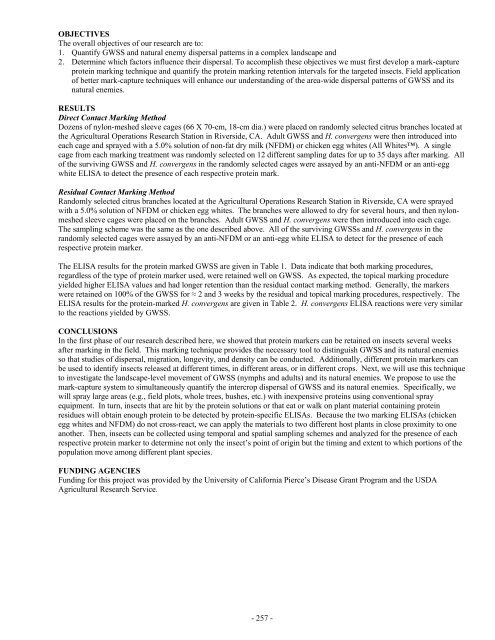Impact Of Host Plant Xylem Fluid On Xylella Fastidiosa Multiplication ...
Impact Of Host Plant Xylem Fluid On Xylella Fastidiosa Multiplication ...
Impact Of Host Plant Xylem Fluid On Xylella Fastidiosa Multiplication ...
You also want an ePaper? Increase the reach of your titles
YUMPU automatically turns print PDFs into web optimized ePapers that Google loves.
OBJECTIVES<br />
The overall objectives of our research are to:<br />
1. Quantify GWSS and natural enemy dispersal patterns in a complex landscape and<br />
2. Determine which factors influence their dispersal. To accomplish these objectives we must first develop a mark-capture<br />
protein marking technique and quantify the protein marking retention intervals for the targeted insects. Field application<br />
of better mark-capture techniques will enhance our understanding of the area-wide dispersal patterns of GWSS and its<br />
natural enemies.<br />
RESULTS<br />
Direct Contact Marking Method<br />
Dozens of nylon-meshed sleeve cages (66 X 70-cm, 18-cm dia.) were placed on randomly selected citrus branches located at<br />
the Agricultural Operations Research Station in Riverside, CA. Adult GWSS and H. convergens were then introduced into<br />
each cage and sprayed with a 5.0% solution of non-fat dry milk (NFDM) or chicken egg whites (All Whites). A single<br />
cage from each marking treatment was randomly selected on 12 different sampling dates for up to 35 days after marking. All<br />
of the surviving GWSS and H. convergens in the randomly selected cages were assayed by an anti-NFDM or an anti-egg<br />
white ELISA to detect the presence of each respective protein mark.<br />
Residual Contact Marking Method<br />
Randomly selected citrus branches located at the Agricultural Operations Research Station in Riverside, CA were sprayed<br />
with a 5.0% solution of NFDM or chicken egg whites. The branches were allowed to dry for several hours, and then nylonmeshed<br />
sleeve cages were placed on the branches. Adult GWSS and H. convergens were then introduced into each cage.<br />
The sampling scheme was the same as the one described above. All of the surviving GWSSs and H. convergens in the<br />
randomly selected cages were assayed by an anti-NFDM or an anti-egg white ELISA to detect for the presence of each<br />
respective protein marker.<br />
The ELISA results for the protein marked GWSS are given in Table 1. Data indicate that both marking procedures,<br />
regardless of the type of protein marker used, were retained well on GWSS. As expected, the topical marking procedure<br />
yielded higher ELISA values and had longer retention than the residual contact marking method. Generally, the markers<br />
were retained on 100% of the GWSS for ≈ 2 and 3 weeks by the residual and topical marking procedures, respectively. The<br />
ELISA results for the protein-marked H. convergens are given in Table 2. H. convergens ELISA reactions were very similar<br />
to the reactions yielded by GWSS.<br />
CONCLUSIONS<br />
In the first phase of our research described here, we showed that protein markers can be retained on insects several weeks<br />
after marking in the field. This marking technique provides the necessary tool to distinguish GWSS and its natural enemies<br />
so that studies of dispersal, migration, longevity, and density can be conducted. Additionally, different protein markers can<br />
be used to identify insects released at different times, in different areas, or in different crops. Next, we will use this technique<br />
to investigate the landscape-level movement of GWSS (nymphs and adults) and its natural enemies. We propose to use the<br />
mark-capture system to simultaneously quantify the intercrop dispersal of GWSS and its natural enemies. Specifically, we<br />
will spray large areas (e.g., field plots, whole trees, bushes, etc.) with inexpensive proteins using conventional spray<br />
equipment. In turn, insects that are hit by the protein solutions or that eat or walk on plant material containing protein<br />
residues will obtain enough protein to be detected by protein-specific ELISAs. Because the two marking ELISAs (chicken<br />
egg whites and NFDM) do not cross-react, we can apply the materials to two different host plants in close proximity to one<br />
another. Then, insects can be collected using temporal and spatial sampling schemes and analyzed for the presence of each<br />
respective protein marker to determine not only the insect’s point of origin but the timing and extent to which portions of the<br />
population move among different plant species.<br />
FUNDING AGENCIES<br />
Funding for this project was provided by the University of California Pierce’s Disease Grant Program and the USDA<br />
Agricultural Research Service.<br />
- 257 -











